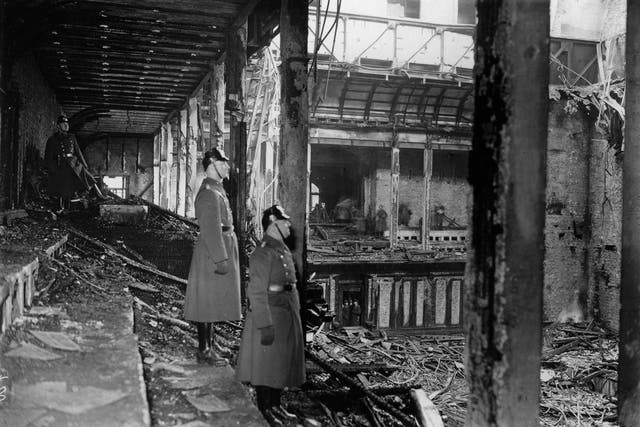

The Reichstag Fire was a dramatic arson attack occurring on February 27, 1933, which burned the building that housed the Reichstag (German parliament) in Berlin. Claiming the fire was part of a Communist attempt to overthrow the government, the newly named Reich Chancellor Adolf Hitler used the fire as an excuse to seize absolute power in Germany, paving the way for the rise of his Nazi regime.
By the late 1920s, Adolf Hitler and his Nationalist Socialist German Workers (Nazi) Party were gaining strength due to growing popular dissatisfaction with the ruling Weimar Republic.
Germany’s economic woes in the early 1930s threw the government into further chaos, with President Paul von Hindenburg forced to replace several chancellors within a short time period. In late January 1933, hoping to make an alliance with the Nazis against more left-wing opponents, Hindenburg reluctantly asked Hitler to serve as chancellor.
With elections set for early March, the Nazis set about suppressing their political opposition. On February 4, Hitler’s cabinet issued the temporary Decree for the Protection of the German People, which restricted the German press and authorized the police to ban political meetings and marches.
Specifically targeting the Communists, Minister of the Interior Hermann Göring ordered a raid on that party’s headquarters in Berlin on February 24. Though the authorities found nothing of note, they claimed that they had uncovered seditious material, including leaflets encouraging an armed revolt.
On the night of February 27, passers-by heard the sound of breaking glass from the Reichstag, and soon after that flames erupted from the building. The blaze would destroy the Reichstag’s gilded cupola, as well as a main chamber, causing some $1 million in damage before firefighters could extinguish it.
Police arrested Marinus van der Lubbe, an unemployed 24-year-old Dutch laborer with Communist sympathies, at the scene. Van der Lubbe reportedly confessed to setting the fire, saying he did it to encourage a worker’s uprising against the German state.
He was later tried in Leipzig, along with three Bulgarian members of the Communist International and a leading German Communist. Van der Lubbe was the only one convicted, and he was beheaded in January 1934.
A few hours after the Reichstag Fire, as Nazi propaganda spread fears of a Communist revolt, Hitler convinced Hindenburg to invoke Article 48 of the Weimar Constitution, which gave the president dictatorial powers and allowed him to make laws for all of Germany’s territorial states.
Hitler and the cabinet quickly drew up a more permanent and expansive Decree for the Protection of the People and the State (known as the Reichstag Fire Decree), which suspended the right to assembly, freedom of the press, freedom of speech and other constitutional protections within Germany.
The decree also removed all restraints on police investigations, allowing the Nazis to arrest and jail their political opponents indiscriminately. That night, the stormtroopers of the Sturmabteilung (SA) rounded up some 4,000 people, many of whom were tortured as well as imprisoned.
The swift and brutal response to the Reichstag Fire bolstered Hitler’s image as Germany’s strong-willed savior from the dreaded “Bolshevism.”
On March 23, meeting at the Kroll Opera House in Berlin, the Reichstag passed the Enabling Act, giving full powers to Hitler. The meeting, which supposedly marked the union of National Socialism with Hindenburg and the German establishment, essentially turned the country over to the Nazis.
By the end of the year, all non-Nazi political parties, labor unions and other organizations had ceased to exist. When Hindenburg died in 1934, the German Army sanctioned Hitler’s decision to combine the posts of president and chancellor, cementing his absolute power in Germany.
The question of who really set the Reichstag fire has remained a matter of enduring debate to the present day.
Many observers, even at the time, challenged the Nazi contention that the arson was a Communist plot. Meanwhile, some diplomats, foreign journalists and liberals within Germany suggested that the Nazis had started the fire themselves as a pretext for taking absolute power.
German Communist Willi Münzenberg spearheaded an investigation that produced The Brown Book on the Reichstag Fire and Hitler Terror, a 1933 bestseller published in Paris that suggested van der Lubbe was a Nazi pawn.
Despite such claims, most historians after the 1960s accepted that van der Lubbe told the truth when he said he acted alone in setting the fire. But the controversy lives on: In his 2013 book Burning the Reichstag, historian Benjamin Hett claimed that scientific evidence proved the Dutchman could not have acted alone, given the extent of the fire and the time he spent inside the Reichstag building.
Mining documents that only emerged after the Cold War, Hett argued that the Nazis who spoke to post-war historians about the fire covered up the extent of the Nazi Party’s involvement.
No matter who may have started the Reichstag Fire, its importance in aiding Hitler and the Nazi Party’s rise to absolute power in Germany is clear. In fact, in the years since that pivotal event, the phrase “Reichstag Fire” has become a powerful metaphor in modern-day politics.
Politicians and pundits on different ends of the political spectrum have invoked it to describe a crisis that a politician or government has supposedly manufactured to sow fear in the public in order to grab more power or achieve a desired political end.
Holocaust Encyclopedia: The Reichstag Fire, U.S. Holocaust Memorial Museum.
Ian Kershaw, Hitler, 1889-1936: Hubris (New York: W.W. Norton and Co., 2000).
Lorraine Boissoneault, “The True Story of the Reichstag Fire and the Nazi Rise to Power,” Smithsonian (February 21, 2017).
Benjamin Carter Hett, “What Really Caused the Reichstag Fire,” History News Network (January 13, 2014).